NCERT Solutions for Class 12 Micro Economics Chapter-1 Introduction to Economics
NCERT TEXTBOOK QUESTIONS SOLVED
Question 1. Discuss the central problems of an economy. [4-6 Marks]
Answer: The three central problems of an economy are:
- What to produce? [CBSE 2004C, 05, 06, 08, 08C, 09, 10; AI 2006, 10]
(a) What to produce refers to a problem in which decision regarding which goods and services should be produced is to be taken.
(b) Since its resources are limited, every economy has to decide what commodities are to be produced and in what quantities.
(c) ‘The guiding principle for an economy here is to allocate resources in such a way that gives maximum aggregate utility to the society. - How to produce?[CBSE 2014C, 2006, 08C, 10, AI 2001, 05, 08, 10, 11]
(a) How to produce refers to a problem in which decision regarding which technique of production should be used is made.
(b) Goods and services can be produced in two ways: by using labour intensive techniques, and by using capital-intensive techniques.
(c) The guiding principle for an economy in such a case has to decide about the techniques of production on the basis of cost of production. Those techniques of production should be used which lead to the least possible cost per unit of commodity or service. - For whom to produce?[CBSE 2014, 2005C, AI 2013]
(a) For whom to produce refers to a problem in which decision regarding which category of people are going to consume a good, i.e., economically poor or rich.
(b) As we know, goods and services are produced for those who can purchase them or have the capacity to buy them.
(c) Capacity to buy depends upon how income is distributed among the factors of production. The higher the income, the higher will be the capacity to buy and vice versa. So, this is a problem of distribution.
(d) The guiding principle is that the economy must see here that important and urgent wants of its citizens are being satisfied for the maximum possible extent or not.
Question 2. What do you mean by the production possibilities of an economy? [ 1 Mark]
Answer: Production possibilities of an economy refer to different combinations of goods and services which an economy can produce from a given amount of resources and a given stock of technology.
Question 3. What is a production possibility frontier? [CBSE 2006C; AI 2006, 09] [1 Mark]
Answer: Production possibility frontier is a curve which depicts all the possible combinations of two goods which can be produced with given resources and technology in an economy.
Question 4. Discuss the subject matter of economics. [3 Marks]
Answer:
- The subject matter of economics includes microeconomics and macroeconomics.
- Microeconomics, studies the behaviour of individual economic units of an economy, like households, firms, individual consumers and producers etc. It does not study the economy as a whole.
- Macroeconomics is the part of economic theory that studies the economy as a whole, such as national income, aggregate employment, general price level, aggregate consumption, aggregate investment, etc.
Question 5. Distinguish between a centrally planned economy and a market economy.
Answer: Out of syllabus
Question 6. What do you understand by positive economic analysis?
Answer: Out of syllabus
Question 7. What do you understand by normative economic analysis?
Answer: Out of syllabus
Question 8. Distinguish between microeconomics and macroeconomics. [AI 2010] [3-4 Marks]
Answer:
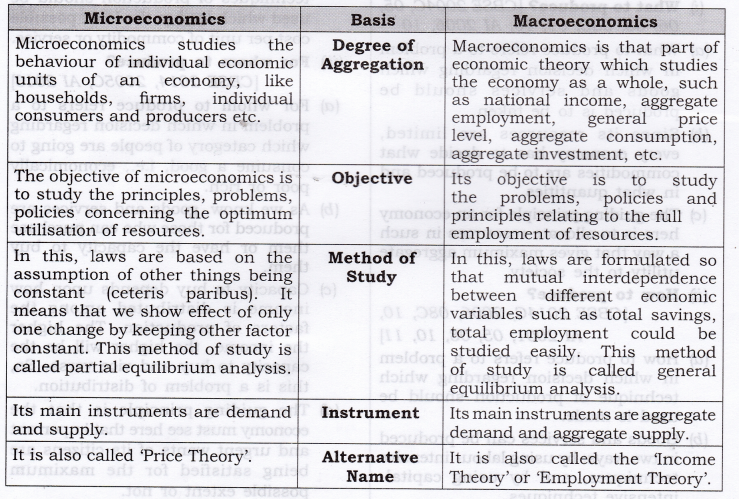
MORE QUESTIONS SOLVED
I. Very Short Answer Type Questions (1 Mark)
Question 1. What is meant by economy? [CBSE 2012]
Answer: Economy is a system which provides people with the means to work and earn living.
Question 2. What is economics?
Answer: Economics is about studying economic problems arising due to limited means (having alternative uses) in relation to unlimited wants.
Question 3. Why does an economic problem arise? [CBSE 2007]
Or
What gives rise to an economic problem? [CBSE, Sample Paper 2008] Or
Why does the problem of choice arise? [CBSE 2004]
Answer: If we are not able to satisfy unlimited wants out of limited resources then the economic problem arises.
Question 4. State two features of resources that give rise to an economic problem.
[CBSE, Sample Paper 2010]
Answer: The two features of resources that give rise to an economic problem are:
- Resources are limited.
- They have alternative uses.
Question 5. Which type of science is economics?
Answer: Economics is a social science.
Question 6. What is the basic reason for economic problem in all economies?
Answer: It is scarcity of resources.
Question 7. What is meant by economising of resources? [CBSE 2003]
Answer: Economising of resources means that resources are to be used in such a manner that maximum output is realised per unit of input. It also means optimum utilisation of resources.
Question 8. What is meant by central problem of an economy?
Answer: The problem of making a choice among alternative uses of resources is known as basic or central problem of an economy.
Question 9. What does a rightward shift of production possibility curve indicate?[CBSE 2007]
Answer: It indicates growth of resources.
Question 10. Give two examples of growth of resources.
Answer:
- Supply of skilled labour (like IT engineers) has increased in India causing a rightward shift in the production of IT software.
- Discovery of oil reserves in the gulf countries has caused a substantial shift to the right in the PPC of these countries.
Question 11. Give two examples of underutilisation of resources.
Answer:
- Related to less developed countries: Labour is underutilised as indicated by mass unemployment in countries like India.
- Related to developed countries: Capital is underutilised during depression when production is decreased owing to lack of demand.
Question 12. Define Opportunity Cost. [CBSE 2007]
Or
Give the meaning of ‘Opportunity Cost’. [CBSE 2008, 09]
Answer: Opportunity cost is the cost of the next best alternative.
Question 13. Define Marginal Rate of Transformation (MRT). [CBSE 2012]
Answer: Marginal rate of transformation is the ratio of a number of units of a good sacrificed to produce an additional unit of another commodity.
Question 14. Why PPC is concave to the point of origin? [CBSE 2011, AI 2007]
Answer: Because of increasing marginal opportunity cost.
Question 15. Define microeconomics.[CBSE 2007C; AI 2005, 2012]
Or
Give the meaning of microeconomics.[CBSE 2009]
Answer: Microeconomics studies the behaviour of individual economic units of an economy, like households, firms, individual consumers and producers etc.
Question 16. Give one/two examples of microeconomics study.[CBSE 2004C, 09, 09C, 11C;AI 2004, 05, 07, 11]
Or
Name any three variables of micro-economics.
Answer:
- Individual demand;
- Individual supply; and
- Individual income.
Question 17. Name any three variables of macroeconomics.
Answer:
- Aggregate demand;
- Aggregate supply; and
- National income.
Question 18. State any two central problems under ‘problem of allocation of resources’.[CBSE Sample Paper 2016]
Answer:
- What to produce and in what quantity?
- How to Produce?
II. Multiple Choice Questions (1 Mark)
Question 1. The law of scarcity
(a) Does not apply to rich, developed countries.
(b) Applies only to the less developed countries.
(c) Implies that consumers’ wants will be satisfied in a socialistic system.
(d) Implies that consumers’ wants will never be completely satisfied.
Answer: (d)
Question 2. The central problem in economics is that of
(a) Comparing the success of command versus market economies.
(b) Guaranteeing that production occurs in the most efficient manner.
(c) Guaranteeing a minimum level of income for every citizen.
(d) Allocating scarce resources in such a manner that society’s unlimited needs or wants are satisfied in the best possible manner.
Answer: (d)
Use the given figure to answer question no. 3.
Question 3. Which one of the following bundles of goods cannot be produced with the resources the economy currently has?

(a) A (b) B
(c) C (d) D
Answer: (d)
Question 4. An economy achieves “productive efficiency” when:
(a) Resources are employed in their most highly valued uses.
(b) The best resources are employed.
(c) The total number of produced goods is the greatest.
(d) Goods and services are produced at least cost and no resources are wasted.
Using the figure gives below answer the following (Q.5 to Q.7)
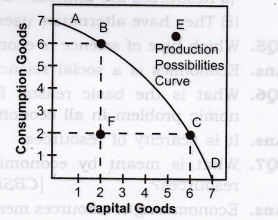
Answer: (d)
Question 5. Which point on PPF shows a “productively efficient” level of output?
(a) A (b) B
(c) C (d) All of the above.
Answer: (d)
Question 6. Which of the following clearly represents a movement toward greater productive efficiency?
(a) A movement from point A to point B.
(b) A movement from point C to point D.
(c) A movement from point F to point C.
(d) A movement from point E to point B.
Answer: (c)
Question 7. Which one of the following alternatives illustrate a decrease in unemployment using the PPF?
(a) A movement down along the PPF.
(b) A rightward shift of the PPF.
(c) A movement from a point on the PPF to a point inside the PPF.
(d) A movement from a point inside the PPF to a point on the PPF.
Answer: (d)
Question 8. If the PPF is linear, i.e., a straight line, which one of the following statements is true?
(a) As the production of a good increases, the opportunity cost of that good rises.
(b) As the production of a good increases, the opportunity cost of that good falls.
(c) Opportunity costs are constant.
(d) The economy is not at full employment when operating on the PPF.
Answer: (c)
Question 9. Which one of the following statements is a reason for the negative slope of PPF?
(a) The inverse relationship between the use of technology and the use of natural resources.
(b) Scarcity at any point of time due to limited amounts of productive resources.
(c) Resource specialisation.
(d) Increasing opportunity costs.
Answer: (b)
Question 10. Capital intensive technique is chosen in a
(a) Labour surplus economy.
(b) Capital surplus economy.
(c) Developed economy.
(d) Developing economy.
Answer: (b)
Question 11. Labour intensive technique is chosen in a
(a) Labour surplus economy.
(b) Capital surplus economy.
(c) Developed economy.
(d) Developing economy.
Answer: (a)
Question 12. If the marginal (additional) opportunity cost is a constant, PPC would be
(a) Convex.
(b) A straight line.
(c) Backward bending.
(d) Concave.
Answer: (b)
Question 13. The branch of economic theory that deals with the problem of allocation of resources is
(a) Micro economic theory.
(b) Macroeconomic theory.
(c) Econometric’s.
(d) None of them.
Answer: (a)
Question 14. Which one of the following options is likely to cause an inward shift in a country’s PPC?
(a) Earthquake destroying resources of the country.
(b) Scientists discovering new machines.
(c) Workers getting jobs in a new metro- project.
(d) The country finds new reserves of crude oil.
Answer: (a)
Question 15. The various combinations of goods that can be produced in any economy when it uses its available resources and technology efficiently are depicted by
(a) Demand curve.
(b) Production curve.
(c) Supply curve.
(d) Production possibilities curve.
Answer: (d)
Question 16. Scarcity is a situation in which
(a) wants exceed the resources available to satisfy them
(b) something is being wasted
(c) people are poor
(d) none of them
Answer: (a)
Question 17. Production Possibilities Curve is also known as
(a) Demand curve
(b) Supply curve
(c) Indifference curve
(d) Transformation curve
Answer: (d)
Question 18. A lot of people die and many factories are destroyed due to floods in a country.
How will it affect the production possibility curve? [CBSE 2014]
(a) PPC will shift towards right
(b) PPC will shift towards left.
(c) PPC will remain the same
(d) None of the above.
Answer: (b)
Question 19. Which of the following is not a subject matter of microeconomics? [AI 2014]
(a) Consumer’s behavior
(b) Market structure
(c) Monetary Policy
(d) Pricing of factor services
Answer: (c)
Question 20. Which of the following is an assumption of Production Possibility Frontier?
(a) Resources are not fully employed.
(b) Resources are not equally efficient for production of the two goods.
(c) Resources are not efficiently employed.
(d) Resources available are not fixed.[ CBSE Sample Paper 2016]
Answer: (b)
III. Short Answer Type Questions (3-4 Marks)
Question 1. Why does an economic problem arise? [CBSE 2006, 07C, 09; Or AI 2007]
State any two causes of economic problem. [CBSE 2005C, 09C, 12;Or AI 2007]
State two characteristics of the economic resources which give rise to economic problem.Or [AI 2007]
Why does problem of choice arise?[CBSE 2004, 05C, 06, 07] Or
Explain three factors that lead to an economic problem.
Answer: Economic problem arises because of scarcity of resources in relation to demand for them.
- Wants are unlimited:
(a)This is a basic fact of human life. Human wants are unlimited.
(b)They are not only unlimited but also grow and multiply very fast. - Resources are limited:
(a)The resources to produce goods and services to satisfy human wants are available in limited quantities. Land, labour, capital and entrepreneurship are the basic scarce resources.
(b)These resources are available in limited quantities in every economy, big or small, developed or underdeveloped, rich or poor. Some economies may have more of one or two resources but not all the resources.
(c)For example, Indian economy has relatively more labour but less capital and land. The U.S. economy has relatively more land but less labour. No economy in the world is comfortable in all the resources. - Resources have alternative uses:
(a)Generally a resource has many alternative uses.
(b)A worker can be employed in a factoiy, in a school, in a government office, self employed and so on.
(c) Like this, nearly all resources have alternative uses. But the problem is that which resource should be put to which use.
Question 2. Give reasons for the following statements:
- Every economy has to make the decision relating to what to produce.
- Problem of choice arises because available resources have alternative uses.
Answer:
- As, we know there is no economy in this world which possesses infinite resources to produce each and everything in infinite quantities.Therefore, if an economy decides to produce a quantity of one commodity, then they have to sacrifice the production of another commodity.
- Resources in eveiy economy are always scarce. But the available resources can be put to alternative uses. Therefore, an economy will always prefer to make use of its resources in production of those goods and services that are most required and sacrifice the production of less- required goods and services.
Question 3. Why do all economies have similar central problems?
Answer: All economies whether developed or developing, have similar central problem because one or more of their resources (land, labour, capital and entrepreneurship) are limited and these resources can be put to alternative uses. The wants of the economies are unlimited. Therefore all economies have to face the basic economic problem of choice (what to produce, how to produce and for whom to produce).
Question 4. State the central problems of an economy. [CBSE Sample Paper 2014]
Answer: The central problems of an economy are:
- What to produce and in what quantity?
- How to produce?
- For whom to produce?
Question 5. Define Production Possibility Curve and state its properties.[CBSE, All India 2013 C]
Answer: Production possibility curve is a curve which depicts all possible combinations of two goods which can be produced with given resources and technology in an economy. Properties of Production Possibility Curve
- PPC is downward sloping: The downward slope of PPC means if the country wants to produce more of one good, it has to produce less quantity of the other goods.
- PPC is concave to the point of origin: Concave shape of PPC implies that the slope of PPC increases. Slope of PPC is defined as the quantity of goods Y given up in exchange for additional unit of goods X.[Slope of Production Possibility Curve]
(=frac { Delta Y }{ Delta X } =frac { Amountquad ofquad Goodquad Yquad lost }{ Amountquad ofGoodquad Xquad gained } )
[Slope of PPC] = MRT = [Marginal Opportunity Cost]
Question 6. State any three assumptions on which a production possibilities curve is based. [CBSE 2013 Q]
Answer: The concept of PP curve is based on the following assumptions:
- First, the amount of resources in the economy is fixed.
- Second, the technology is given and unchanged.
- Third, the resources are efficient and fully employed.
Using the figure given below answer the following (Q.9 & Q.10).
Question 7. Does production take place only on PPC?
Answer: Both Yes and No.
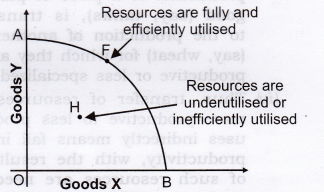
Yes, production will take place on PPC, if the given resources are fully and efficiently utilised. In such case, production will take place at any point on the curve AB, like point F. No, production will take place on PPC, if the resources are either underutilised or inefficiently utilised or both. In such case, production will take place on any point below the curve AB, like point H. Any point below the PP curve, thus highlights the problem of unemployment and inefficiency in the economy.
Question 8. “An economy always produces on but not inside PPC. Defend or refute.
Answer: The given statement is refuted. An economy operates on PPC, only when resources are fully and efficiently utilised. It means, if there is unemployment or inefficient use of resources, the economy may operate inside PPC. So, the economy may operate at point ‘H’ (Figure), in addition to the points on the curve AB on PPC.
Question 9. Why is Production Possibilities Curve concave? Explain.[CBSE 2011, AI 2014, 2007]
Answer:
- PPC is concave because of increasing marginal opportunity cost (MOC).
- This behavior of the MOC is based on the assumption that all resources are not equally efficient in production of all goods.
- Rise in opportunity cost occurs when factors (resources) which are specialized or more adopted for production of a piece of particular good (say, tanks), is transferred to the production of another good (say, wheat) for which they are less productive or less specialized.
- Thus, transfer of resources from more productive to less productive uses indirectly means fall in their productivity, with the result more of such resources are needed to produce an additional unit of the other commodity. Thus marginal opportunity cost goes on increasing making the PP curve concave in shape.
Question 10. Give reasons for the following statements:
- A Production Possibility Frontier is always a downward sloping concave curve.
- An efficient economy would always produce a combination of goods
that lies on the given Production Possibility Frontier. - Growth of an economy is represented in the form of a rightward shift of a Production Possibility Frontier.
Answer:
- A PPF slopes downward to indicate if an economy chooses to produce more of one commodity, then it would have to reduce the production of another commodity.
The concave shape of PPF is due to Increase in Marginal Opportunity Cost. - Any point on a given PPF presents a production possibility wherein all the available resources in an economy get fully utilized.
Any combination located below the given PPF shows an under utilization of available resources. Likewise, any point to the right of the PPF is beyond the available resources. - By economic growth, we mean that an economy has developed greater capacity to produce larger quantity of goods by acquiring more resources. Graphically, this would be represented by a rightward shift of PPF.
Question 11. Explain the meaning of opportunity cost with the help of production possibility schedule.[CBSE, All India 2013]
Answer: Opportunity cost of any commodity is the amount of other good which has been given up in order to produce that commodity. Alternatively opportunity cost of a given activity is the value of the next best activity.
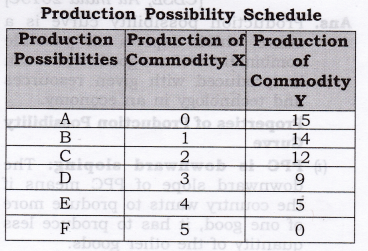
Initially at combination B, in order to produce one unit of X, the economy has to sacrifice one unit of Y. So, at combination B, opportunity cost is 1 unit. At combination C, for producing additional unit of commodity X, the economy has to sacrifice 2 units of commodity Y. So, at combination C, opportunity cost is 2 units. Similarly, at combination D, for producing additional unit of commodity X, the economy has to sacrifice 3 units of commodity Y. So, at combination C, opportunity cost is 3 units and so on.
Question 12. Define Marginal Opportunity Cost. Explain the concept with a hypothetical numerical example.[CBSE Sample Paper 2016]
Answer:
- Marginal opportunity cost is an addition to a cost in terms of a number of units of a commodity sacrificed to produce one additional unit of another commodity.
- Marginal opportunity cost can also be termed marginal rate of transformation, Marginal rate of transformation is the ratio of number of units of a good sacrificed to produce one additional unit of another commodity.
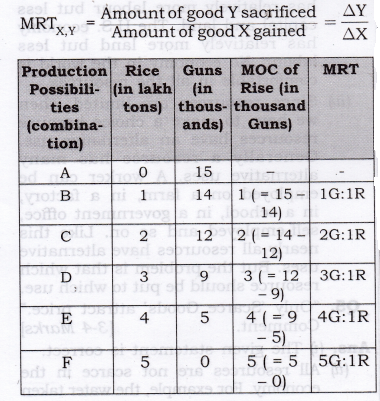
IV. True Or False
Giving reasons, state whether the following statements are true or false.
Question 1. An economy always manages to meet all the needs of the people living in the country.
Answer: False: An economy always tries to provide means of living to all the people. It may be successful (as in most of the developed countries), or it may not be successful (as in many developing countries) to achieve its objective.
Question 2. In the context of an economy when we talk about ‘scarcity’, we refer to short supply of land.
Answer: False: Scarcity refers to limited availability of all types of goods and services in relation to their requirements. The concept of scarcity, thus, is not limited to land alone.
Question 3. Economic problem arises due to plenty of resources.
Answer: False: Economic problem arises due to scarcity of resources and alternative uses of various means.
Question 4. Because of destruction caused by war, a country’s PPF will shift to the left.
Answer: True: Country’s PPF will shift to the left; this will be due to the fact that the country’s capacity to produce will get reduced.
Question 5. A job guarantee scheme will lead to a rightward shift of PPF.
Answer: False: A job guarantee scheme does not add anything new to a country’s resources. This will only ensure that available unutilised or unemployed resources are productively employed.
Question 6. If a PPF shifts to the right, the new PPF will be parallel to the original.
Answer: False: A new PPF need not be parallel to the old one. It can take any possible shape.
Question 7. A ‘Production Possibility Frontier’ (PPF) is always represented as a upward sloping curve.
Answer: False: A PPF represents different combinations of two commodities that can be produced with the help of available resources in an economy. If an economy decides to produce a larger quantity of one commodity, it would be left with lesser resources to produce another commodity. A downward sloping curve represents this relationship.
Question 8. If the economy operates inside PPC, it shows full utilisation of resources.
Answer: False: If economy operates inside PPC, it shows underutilsation of resources.
Question 9. Growth of resources shifts PPC towards left.
Answer: False: Growth of resources increases the capacity of economy to produce more. It shifts PPC towards right and not left.
Question 10. PPC is concave shaped as production of one good can be increased only by reducing quantity of another good.
Answer: False: PPC is concave shaped due to increasing marginal opportunity cost.
Question 11. Economy can never operate outside PPC with the given resources and technology.
Answer: True: Economy can never operate outside PPC with the given resources and technology as all points outside PPC are unattainable.
Question 12. Economy always operates on PPC.
Answer: False: Economy operates on PPC only when resources are fully and efficiently utilised. If resources are not fully and efficiently utilized, economy operates at any point inside PPC.
Note: As per CBSE guidelines, no marks will be given if reason to the answer is not explained.
V. Higher Order Thinking Skills Questions
Question 1. Define Marginal Opportunity Cost.[AI 2008] [1 Mark]
Answer: Marginal opportunity cost is an addition to the cost in terms of a number of units of a commodity sacrificed to produce an additional unit of another commodity.
Question 2. How does Maruti Udyog Ltd. fix the prices of its cars, is it studied in macroeconomics? [ 1 Mark]
Answer: False: Macroeconomics is the study of aggregates e.g., determination of general price level in an economy. The principles underlying the pricing of a single good by a single firm or single industry are studied in microeconomics.
Question 3. Whether the cotton textile industry is an example of micro or macroeconomics?
Answer: Microeconomics.
Question 4. “Scarcity and choice go all together”. Defend or refute. [3-4 Marks]
Answer:
- We defend this statement because scarcity arises as resources are limited. The resources to produce goods and services to satisfy human wants are available in limited quantities. Land, labour, capital and entrepreneurship are the basic scarce resources.
- These resources are available in limited quantities in eveiy economy, big or small, developed or underdeveloped, rich or poor. Some economies may have more of one or two resources but not all resources.
- For example, the Indian economy has relatively more labour but less capital and land. The U.S. economy has relatively more land but less labour. No economy in the world is comfortable in all the resources.
- Since resources are limited, then we have to make a choice because resources have an alternative use. Generally a resource has many alternative uses. A worker can be employed on a farm, in a factory, in a school, in a government office, self-employed and so on. Like this nearly all resources have alternative uses. But the problem is that which resource should be put to which use.
Question 5. “Only ‘Scarce Goods’ attract price.” Comment. [3-4 Marks]
Answer:
- The given statement is correct.
- All resources are not scarce in the economy. For example, the water taken
from river or air we breathe is abundant in relation to wants. Such goods are available free of cost. These goods are known as Non-Economic Goods. - On the other hand, some goods are scarce in relation to their wants. For example, diamonds, petrol, electricity, etc. are scarce in relation to wants. These goods command price and are known as Economic Goods.
Question 6. A lot of people died and many factories were destroyed in an earthquake. How will it affect the PPC of the economy? [3-4 Marks]
Answer: PPC of the economy will shift to the left from PP to P,Pr It happens because the number of possible combinations available with the economy has decreased due to destruction of resources in the economy.

Question 7. Massive unemployment will shift PPC to the left. Defend or refute. [3-4 Marks]
Answer: The given statement is refuted. Massive unemployment does not decrease the capacity of economy to produce. So, there will be no shift of PPC. However, due to unutilisation of human resources, economy will operate at some point inside PPC as shown in the adjacent figure at point U.

VI. Value Based Questions
Question 1. A country’s resources are fully and p efficiently employed. The problem of scarcity exists. What advice would be given to raise the efficiency level of the human resource to fight scarcity? [CBSE Sample Paper 2013] [1 Mark]
Answer: Spread of education and training. Value: Awareness about efficient utilization of resources
Question 2. In an underdeveloped economy why there is the need of efficient utilization of resources? [1 Mark]
Answer: Developmental needs are more in underdeveloped economy and these are fulfilled with our limited resources. Value: Critical thinking
Question 3. India is a labour abundance and capital scarce economy. Which technique of production should be used to produce the commodity?[1 Mark]
Answer: India should adopt labour intensive technique.
Value: Analytic
Question 4. As water resources are limited in our country, how can we economise the water resources so that it could not cause a future problem for us? Give any two suggestions. [1 Mark]
Answer:
- Rainwater should be conserved by rain water harvesting.
- Water wastage should be avoided i.e., economical use of water.
Value: Awareness about efficient use of water.
Question 5. Scarcity of resources is a universal phenomenon and is not confined to poor and backward countries only. Comment.
Answer: All countries, rich and poor, face the problem of choice due to scarcity of resources to fulfil unlimited wants. Value: Critical thinking
Question 6. The problems of scarcity of resources and their alternate uses arise everywhere but particularly in backward countries. For their solution non-economic considerations can be stressed. How?[1 Mark]
Answer: Central problems, what to produce?, How to produce? and for whom to produce?, can be solved in poor countries by laying more stress on the social aspects, e.g., public utility services may be developed, labour intensive techniques may be preferred and the distribution of national income may be made equitable.
Value: Analytic
Question 7. Although water is useful, yet it is cheap. On the contrary, diamond is not much of use, still it is very expensive. Give an economic reason for this paradox. [ 1 Mark]
Answer: The economic reason for this paradox is scarcity. Although water is useful, yet it is cheap due to its abundance in the economy. Diamonds are very expensive because they are scarce and people are ready to pay a high price. Value: Analytic
Question 8. Why is it that on one hand coal is found in plenty, yet it is scarce while on the other, a rotten vegetable is rare but not scarce? [1 Mark]
Answer: Coal is found in plenty yet it is scarce because its demand is also high. Scarcity means that availability is less than sufficient to satisfy all wants or desires. On the other hand, a rotten vegetable is rare but not scarce because there is no demand or want for a rotten vegetable. Value: Analytic
Question 9. A farmer is getting more profit by producing opium rather than that of wheat. In situation of famine which crop should be produced?
Answer: Production of wheat. Because in situation of famine, food grain like wheat is required more than opium. Value: Social welfare
Question 10. Large number of technical training institutions have been started by the government. State its economic value in the context of production possibility frontier.[Foreign 2014] [1 Mark]
Answer: This would lead to technological innovations in the economy. When the level of technology improves production possibility frontier is expected to shift to the right. There would be better utilization of the resources and the economy will move closer to the production possibility frontier.
Value: Economic Growth with technological innovation
Question 11. Unemployment is reduced due to the measures taken by the government. State its economic value in the context of production possibilities frontier. [CBSE 2014] [1 Mark]
Answer: When unemployment is reduced due to the measures taken by the government, the economy will be able to realize its production potential (Full employment) level.
Value: Efficient utilization of resources
Question 12. The government has started promoting foreign capital. What is its economic value in the context of Production Possibilities Frontier? [AI2014] [1 Mark]
Answer: The inflow of foreign capital is expected to increase the availability of the resources in an economy, which will thereby shift the production possibility frontier to the right. Value: Economic Growth with increase in resources
Question 13. Name the economic value achievable when attempts are made to increase resources in the country. [CBSE 2014C] [1 Mark]
Answer: The economic value here is economic growth in the country, which will thereby shift the production possibility frontier to the right. Value: Economic Growth
Question 14. Production in an economy is below to its potentiality due to unemployment. Government starts employment generation schemes. Explain its effects by using production possibility curve. [CBSE 2013] [3-4 Marks]
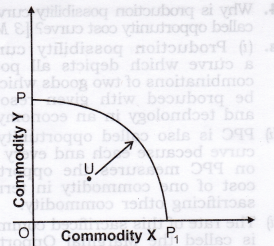
Answer: Production possibility curve is a curve which depicts all the possible combinations of goods which can be produced with given resources and technology in an economy i.e., producing goods at its full potentiality. Production below the potentiality means that total production in the economy is somewhere below the production possibility curve PPi; for example, point U in the diagram. We know production below the production possibility curve highlights unemployment. When government starts employment generation schemes, the economy moves towards the full employment, thereby removes unemployment. So, economy comes back to its potential level.
Value: Analytic
Question 15 There are various sources of income a teacher has; such as,
- He can earn Rs 40000 from teaching in school.
- He can earn Rs 50000 by tuition/ coaching
- He earns Rs 60000 by writing the help book guides.
What is the opportunity cost of his teaching in school? Why should he choose teaching profession? [1 Mark]
Answer: Opportunity cost of teaching is the writing of books. He should choose teaching profession because it provides maximum social welfare. Value: Social welfare
Question 16. Economic slowdown in some parts of the world has adversely affected demand for Indian exports. What will be its effect on the production Possibilities frontier of India? Explain. [CBSE Sample Paper 2013][3-4 Marks]
Answer: There will be no effect on Production Possibility Frontier (PPF). It is because PPF shows only what a country can potentially produce, and not what it actually produces. Slowdown by reducing demand for exports may ultimately bring down output. Assuming that the country’s actual production is somewhere on PPF, Slowdown may result in the country producing at a point somewhere below PPF as shown in the figure at point U.
Value: Analytic

Question 17. Using a diagram explain what will happen to the PPC of Bihar if the river Kosi causes widespread floods?[CBSE Sample Paper 2014] [3-4 Marks]
Answer: If the river Kosi causes widespread floods in Bihar, it will lead to destruction of resources in Bihar. This will shift the PPC leftward. Initially PPC is PP. With floods, the PPC will shift to ({ P }_{ 1 }{ P }_{ 1 })
Value: Analytic
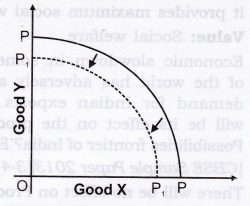
VII. Applications Based Questions
Question 1. A teacher is getting Rs 6,000 per month as salary. If he leaves the job and starts tuition work, he is expected to earn Rs 5,000 per month. What would be his opportunity cost? [1 Mark]
Answer: The opportunity cost of school job is Rs 5,000 p.m., that the teacher could have earned in the alternative use, by doing tuition work.
Question 2. A doctor has a private clinic in New Delhi and his annual earnings are Rs 10 lakh. If he works in a government hospital in New Delhi, his annual earning will be Rs 8 lakh. What is the opportunity cost of having a clinic in New Delhi? [1 Mark]
Answer: The opportunity cost of opening a clinic in New Delhi is Rs 8 lakh, that he could have earned in the next best alternative use, by working in a government hospital in New Delhi.
Question 3. With the same amount of resources a farmer can feed the following combination of goats and horses:

Taking into consideration the options available with him, find out the opportunity cost of the farmer of feeding one horse. [1 Mark]
Answer: The opportunity cost of the farmer ‘of feeding one horse is 3 goats i.e.,
(frac { 168-150 }{ 50-44 } =frac { 18 }{ 6 } =frac { 3 }{ 1 } )
Thus, the opportunity cost of feeding one horse is 3 goats.
Question 4. Why is production possibility curve also called opportunity cost curve? [3 Marks]
Answer:
- Production possibility curve is a curve which depicts all possible combinations of two goods which can be produced with given resources and technology in an economy.
- PPC is also called opportunity cost curve because each and every point on PPC measures the opportunity cost of one commodity in terms of sacrificing other commodity.
- The rate of this sacrificed commodity is called the Marginal Opportunity Cost of the expanding good.
Question 5. What will be the impact of recently launched ‘Clean India Mission’ (Swachh Bharat Mission) on the Production Possibilities curve of the economy and why? [CBSE 2015][3 Marks]
Answer: Cleanliness reduces chances of people falling ill and, thus ensure better health. This in turn will reduce forced absenteeism from work, raise efficiency level and thus raise country’s production potential. Rise in potential shifts PP curve to the right.
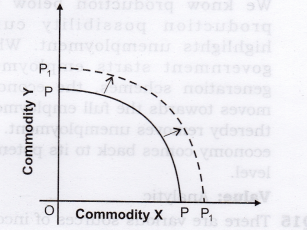
Question 6. What will likely be the impact of large scale outflow of foreign capital on Production Possibility Curve of the economy and why? [CBSE 2015] [3 Marks]

Answer:
- The Production Possibility Curve shifts to the left.
- It is so because outflow of foreign capital decreases the capital resource in our country leads to fall in production capacity of our country.
- It can be explained with the help of the diagram that PP is at full employment level and due to outflow of foreign capital it shifts leftwards P1P1.
Question 7. What is likely to be the impact of ‘Make in India’ appeal to the foreign investors by the Prime Minister of India, on the production possibilities frontiers of India? Explain.[AI 2015] [3 Marks]
Answer: (i) The production possibility frontier of India shifts rightward because of ‘Make in India’ appeal.
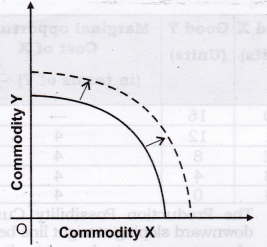
(ii) It is so because it attracts foreign companies or investors to set up factories in India and invest in country’s infrastructure.
(iii) It leads to huge capital inflow shifting the production possibility curve rightward as shown in the figure.
Question 8. What is likely to be the impact of efforts towards reducing unemployment on the production potential of the economy? Explain. [AI 2015] [3 Marks]
Answer:
- The economy moves towards the full employment, thereby removes unemployment.
- This can be done when government starts employment generation schemes. By this, economy moves towards full employment and production potentiality of an economy increases.
- It can be explained with the help of the following diagram. In the given figure,
from unemployment (U), we are moving towards full employment (F).

Question 9. Giving reason comment on the shape of Production Possibilities curve based on the following schedule. [CBSE 2015] [3 Marks]
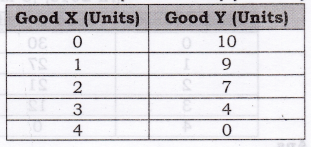
Answer:
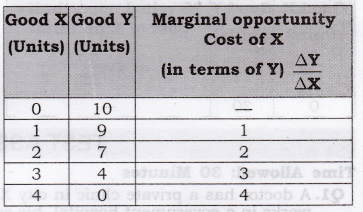
The Production Possibility Curve is downward sloping concave because of increasing marginal opportunity cost.
Question 10. Giving reason comment on the shape of Production Possibilities curve based on the following schedule. [CBSE 2015] [3 Marks]
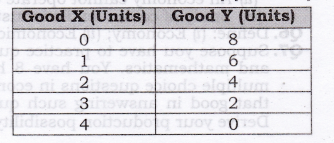
Answer:
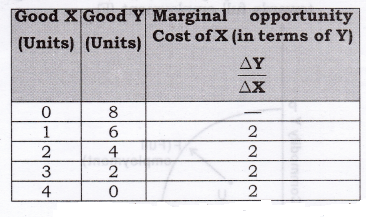
The Production Possibility Curve is downward sloping straight line because of constant marginal opportunity cost.
Question 11. Giving reason comment on the shape of Production Possibilities curve based on the following schedule. [AI 2015] [3 Marks]
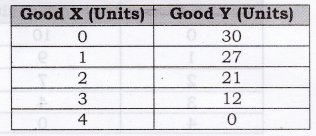
Answer:
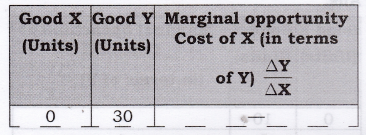

The Production Possibility Curve is downward sloping straight line because of constant marginal opportunity cost.
Question 12. Giving reason comment on the shape of Production Possibilities Curve based on the following schedule. [AI 2015] [3 Marks]
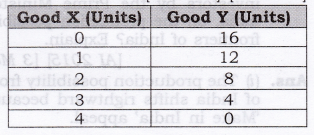
Answer:
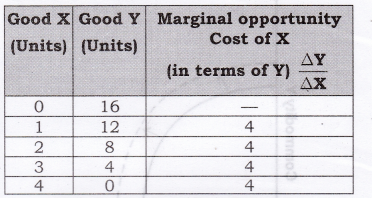
The Production Possibility Curve is downward sloping straight line because of constant marginal opportunity cost.
NCERT SolutionsAccountancyBusiness StudiesMicro EconomicsCommerce
<!–
–>